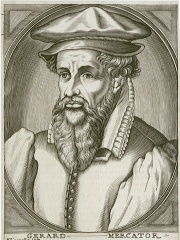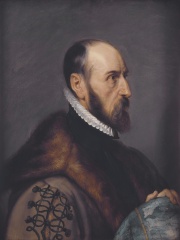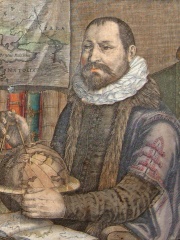


The Most Famous
GEOGRAPHERS from Belgium
This page contains a list of the greatest Belgian Geographers. The pantheon dataset contains 67 Geographers, 3 of which were born in Belgium. This makes Belgium the birth place of the 8th most number of Geographers behind Turkey and Russia.
Top 3
The following people are considered by Pantheon to be the most legendary Belgian Geographers of all time. This list of famous Belgian Geographers is sorted by HPI (Historical Popularity Index), a metric that aggregates information on a biography’s online popularity.

1. Gerardus Mercator (1512 - 1594)
With an HPI of 76.63, Gerardus Mercator is the most famous Belgian Geographer. His biography has been translated into 66 different languages on wikipedia.
Gerardus Mercator (; 5 March 1512 – 2 December 1594) was a Flemish geographer, cosmographer and cartographer. He is most renowned for creating the 1569 world map based on a new projection which represented sailing courses of constant bearing (rhumb lines) as straight lines—an innovation that is still employed in nautical charts. Mercator was a notable maker of globes and scientific instruments. In addition, he had interests in theology, philosophy, history, mathematics and geomagnetism. He was also an accomplished engraver and calligrapher. Unlike other great scholars of the age, he travelled little and his knowledge of geography came from his library of over a thousand books and maps, from his visitors and from his vast correspondence (in six languages) with other scholars, statesmen, travellers, merchants and seamen. Mercator's early maps were in large formats suitable for wall mounting but in the second half of his life, he produced over 100 new regional maps in a smaller format suitable for binding into his Atlas of 1595. This was the first appearance of the word Atlas in reference to a book of maps. However, Mercator used it as a neologism for a treatise (Cosmologia) on the creation, history and description of the universe, not simply a collection of maps. He chose the word as a commemoration of the Titan Atlas, "King of Mauretania", whom he considered to be the first great geographer. A large part of Mercator's income came from sales of terrestrial and celestial globes. For sixty years they were considered the finest in the world, and were sold in such numbers that there are many surviving examples. This was a substantial enterprise involving the manufacture of the spheres, printing the gores, building substantial stands, packing and distributing them all over Europe. He was also renowned for his scientific instruments, particularly his astrolabes and astronomical rings used to study the geometry of astronomy and astrology. Mercator wrote on geography, philosophy, chronology and theology. All of the wall maps were engraved with copious text on the region concerned. As an example, the famous world map of 1569 is inscribed with over five thousand words in fifteen legends. The 1595 Atlas has about 120 pages of maps and illustrated title pages, but a greater number of pages are devoted to his account of the creation of the universe and descriptions of all the countries portrayed. His table of chronology ran to some 400 pages fixing the dates (from the time of creation) of earthly dynasties, major political and military events, volcanic eruptions, earthquakes and eclipses. He also wrote on the gospels and the Old Testament. Mercator was a devout Christian born into a Catholic family at a time when Martin Luther's Protestantism was gaining ground. He never declared himself as a Lutheran but was clearly sympathetic, and he was accused of heresy by Catholic authorities; after six months in prison he was released unscathed. This period of persecution is probably the major factor in his move from Catholic Leuven (Louvain) to a more tolerant Duisburg, in the Holy Roman Empire, where he lived for the last thirty years of his life. Walter Ghim, Mercator's friend and first biographer, describes him as sober in his behaviour, yet cheerful and witty in company, and never more happy than in debate with other scholars.

2. Abraham Ortelius (1527 - 1598)
With an HPI of 68.83, Abraham Ortelius is the 2nd most famous Belgian Geographer. His biography has been translated into 59 different languages.
Abraham Ortelius (; also Ortels, Orthellius, Wortels; 4 or 14 April 1527 – 28 June 1598) was a cartographer, geographer, and cosmographer from Antwerp in the Spanish Netherlands. He is recognized as the creator of the first modern atlas, the Theatrum Orbis Terrarum (Theatre of the World). Along with Gemma Frisius and Gerardus Mercator, Ortelius is generally considered one of the founders of the Netherlandish school of cartography and geography. He was a notable figure of this school in its golden age (approximately 1570s–1670s) and an important geographer of Spain during the age of discovery. The publication of his atlas in 1570 is often considered as the official beginning of the Golden Age of Netherlandish cartography. He was the first person proposing that the continents were joined before drifting to their present positions.

3. Jodocus Hondius (1563 - 1612)
With an HPI of 57.31, Jodocus Hondius is the 3rd most famous Belgian Geographer. His biography has been translated into 23 different languages.
Jodocus Hondius (Latinized version of his Dutch name: Joost de Hondt) (17 October 1563 – 12 February 1612) was a Flemish and Dutch engraver and cartographer. He is sometimes called Jodocus Hondius the Elder to distinguish him from his son Jodocus Hondius II. Hondius is best known for his early maps of the New World and Europe, for re-establishing the reputation of the work of Gerard Mercator, and for his portraits of Francis Drake. He inherited and republished the plates of Mercator, thus reviving his legacy, also making sure to include independent revisions to his work. One of the notable figures in the Golden Age of Dutch cartography (c. 1570s–1670s), he helped establish Amsterdam as the center of cartography in Europe in the 17th century.
Pantheon has 3 people classified as geographers born between 1512 and 1563. Of these 3, none of them are still alive today. The most famous deceased geographers include Gerardus Mercator, Abraham Ortelius, and Jodocus Hondius.
Deceased Geographers
Go to all Rankings
Gerardus Mercator
1512 - 1594
HPI: 76.63
Abraham Ortelius
1527 - 1598
HPI: 68.83
Jodocus Hondius
1563 - 1612
HPI: 57.31






